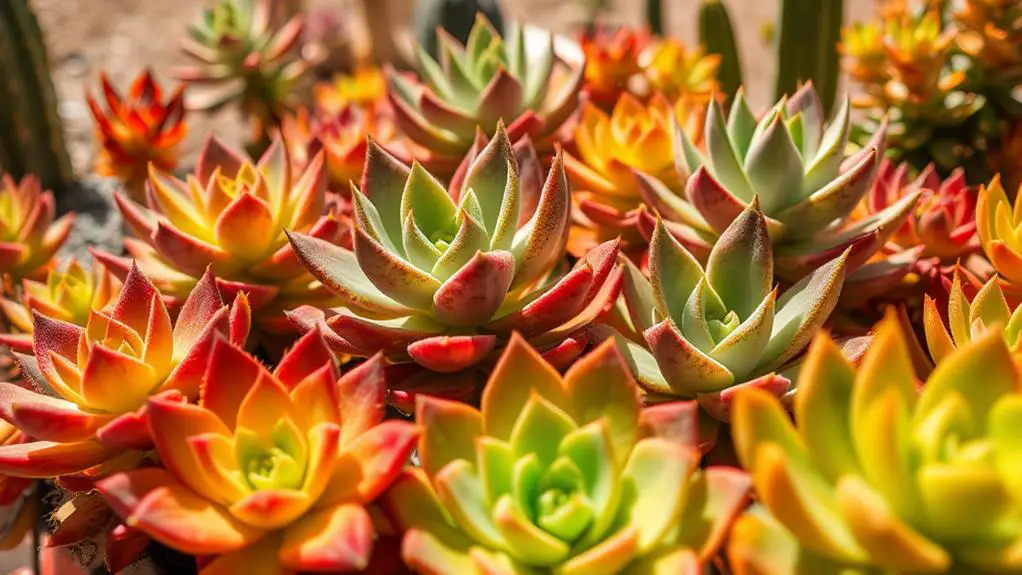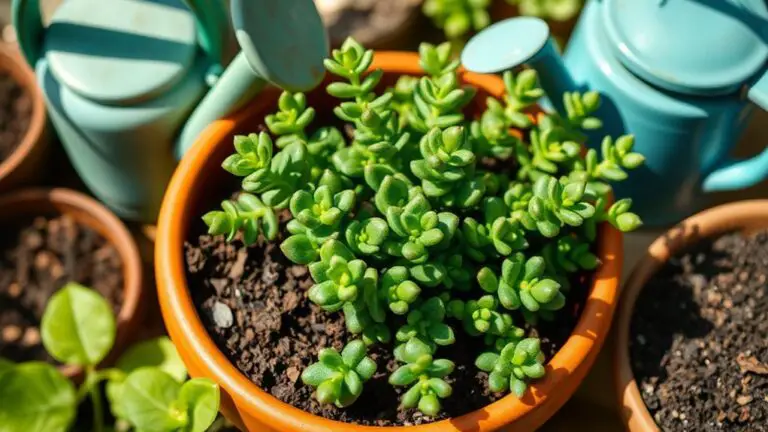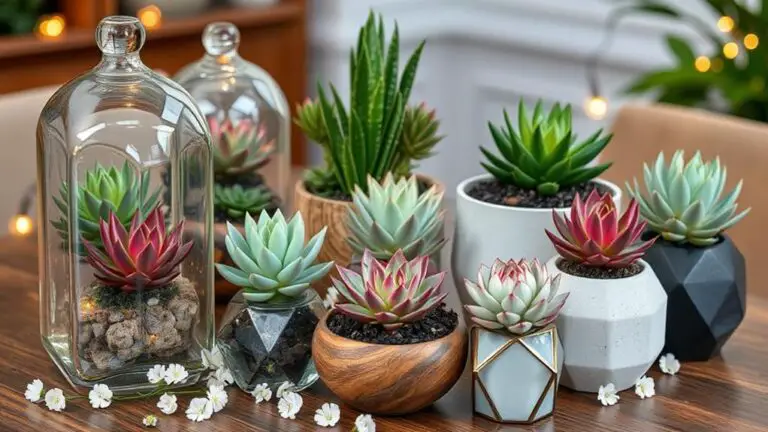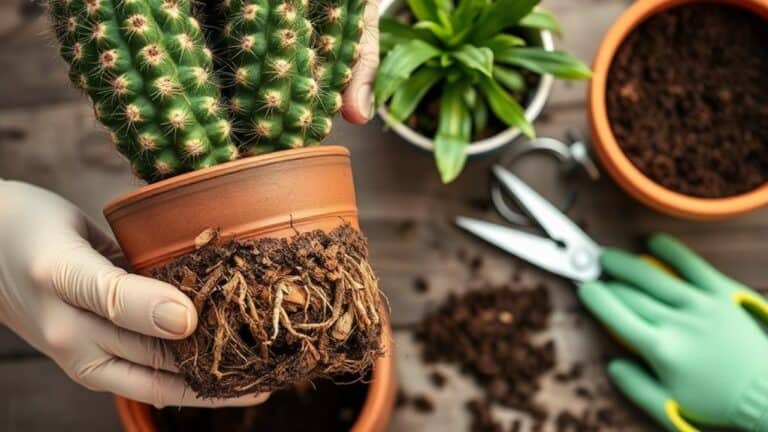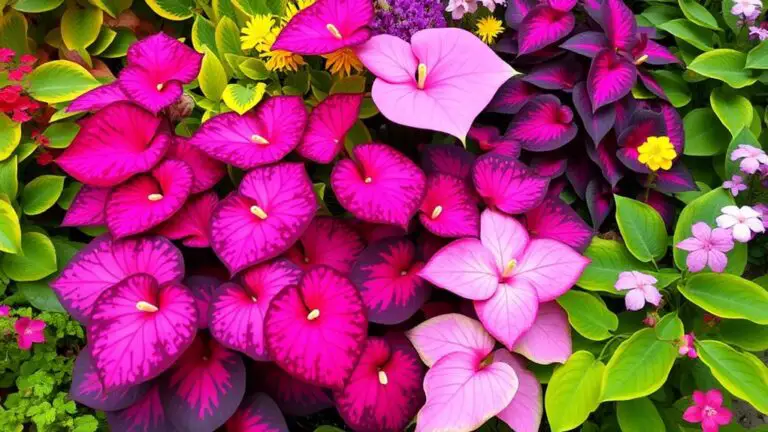Is Sun Stress Good for Succulents?
When you think about caring for succulents, you might wonder if sun stress is actually beneficial for these hardy plants. While increased sunlight can bring out stunning reds, purples, and yellows in their leaves, it's essential to understand the balance needed to avoid damage. You'll need to acclimate your succulents gradually to prevent sunburn and stunted growth. So, how do you achieve that perfect mix of sun exposure without harming your plants? Let's explore the nuances of sun stress and discover how to manage it effectively for healthier, more vibrant succulents.
Understanding Sun Stress
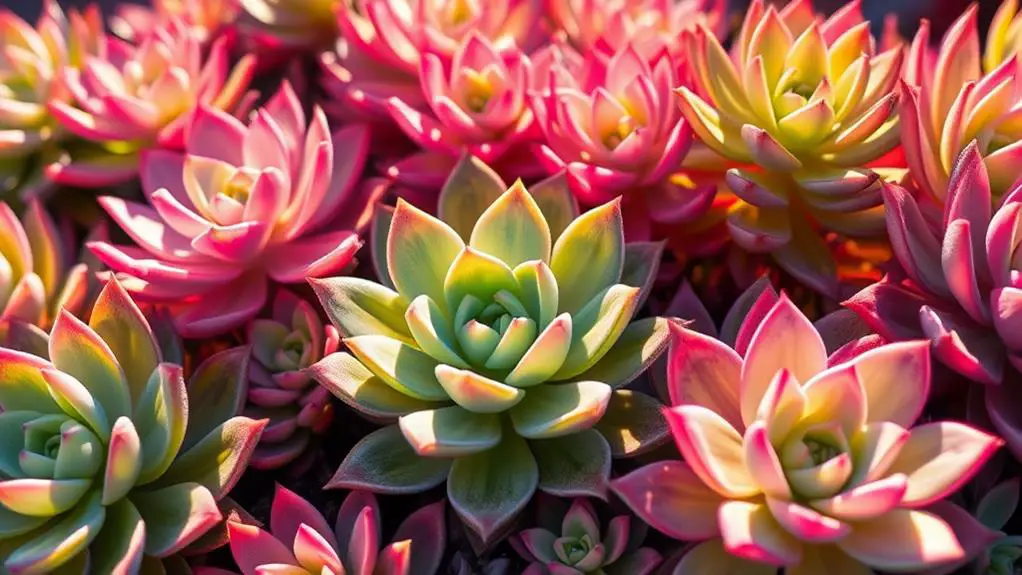
Understanding sun stress is essential for any succulent enthusiast. Sun stress refers to how succulents react to more sunlight, especially in summer. You'll notice changes in their color, shape, and growth. Succulents adapt to these extreme conditions by activating protective pigments like anthocyanin. This often results in vibrant colors like red and yellow, making your plants look stunning.
However, it's important to know that not all succulents handle sun stress well. While some thrive and show off those beautiful hues, others might show signs of sunburn. Look out for indicators like leaves turning reddish or purple, crispy edges, and stunted growth. If the stress becomes too severe, your plants could suffer.
To manage sun stress effectively, gradual acclimatization is key. Don't suddenly expose your succulents to intense sunlight. Instead, slowly increase their sun exposure over time. This helps them adapt without getting sunburned.
Also, keep an eye on their moisture levels. Too much sun combined with dehydration can be harmful.
Benefits of Sun Stress
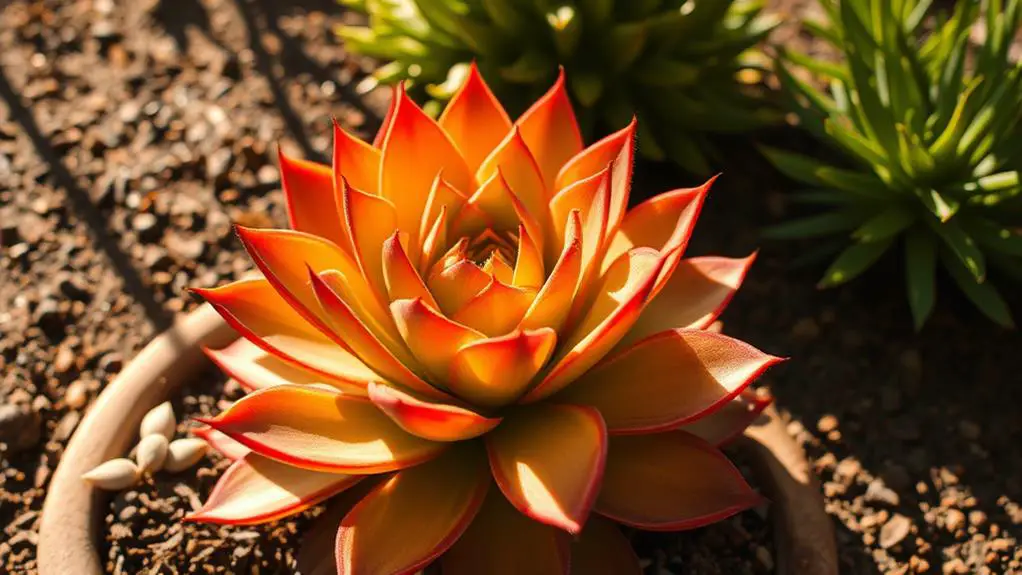
The allure of sun stress lies in its transformative effects on succulents. When succulent plants experience sun stress, they activate protective pigments like anthocyanin. These pigments give your plants vibrant hues such as red, purple, and yellow, making them stand out beautifully in your garden.
Increased sunlight exposure also promotes compact growth, which improves the overall structure and resilience of your succulents. This means your plants won't just look good; they'll be stronger and healthier.
Sun stress mimics the natural habitat of succulents, which are adapted to thrive in high sunlight and arid conditions. As a result, your plants develop stronger root systems, which is essential for their long-term health.
Some succulent species may even show increased flowering when they experience sun stress. This contributes to their reproductive success and adds extra beauty to your collection.
Additionally, controlled sun stress can lead to thicker leaves. These thicker leaves act as a protective adaptation against dehydration and environmental stressors, enhancing the plant's overall health.
In short, the benefits of sun stress are many, from vibrant hues and better structure to stronger roots and increased flowering. Your succulents will thank you!
Signs of Sun Stress
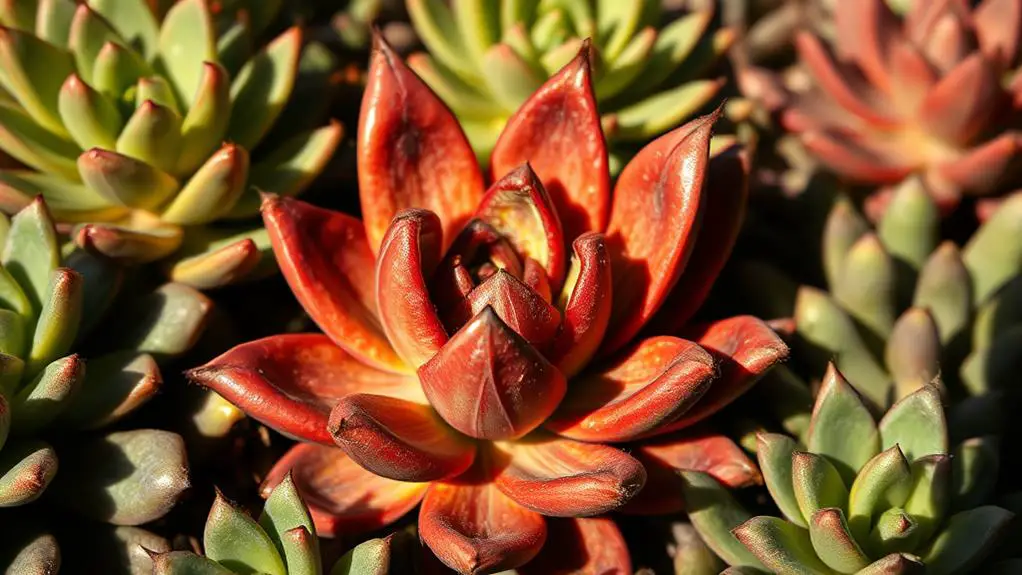
When your succulents start showing reddish or purple hues, it's a sign they're producing more anthocyanins to protect against UV light.
Crispy or brown leaf edges, along with sunburn spots, indicate they're getting too much sun, so you might need to adjust their light exposure.
Keep an eye out for wrinkled leaves and stunted growth, as these can signal stress from too much sunlight and not enough water.
Color Change Indicators
Noticeable color changes in succulents often signal sun stress, showcasing vibrant reds, purples, or yellows. These vivid hues result from increased anthocyanin pigment production, which acts as a protective response to UV exposure. When you see these color shifts, it's your succulent's way of adapting to its environment.
Here are common indicators of sun stress:
- Crispy or brown leaf edges: This suggests too much direct sunlight and a need for adjustment.
- Stunted growth: A sign that the plant is struggling to cope with the stress.
- Sunburn spots on leaves: These are clear indicators that the succulent is receiving excessive stress from the sun.
- Enhanced colors during summer months: Many succulent types show their most vibrant colors in response to increased light during this season.
It's vital to monitor for signs of excessive stress, such as shriveling or severe discoloration.
These indicate that the plant is under duress and could suffer irreversible damage if conditions don't improve.
Gradually acclimating your succulent to more sunlight can help enhance color changes without causing harm.
Remember, morning sun exposure is often best for many succulent species.
Keeping a close eye on your plant's health will guarantee it thrives in its sunny spot.
Managing Sunburn Symptoms
During periods of intense sunlight, succulents can suffer from sunburn, manifesting as crispy or brown leaf edges. These signs indicate excessive sun exposure and potential moisture loss.
You might also notice leaf color changes, such as reddish or purple hues. While these colors can be a natural adaptation to increased sunlight, they may also suggest the plant is experiencing stress.
To manage sunburn symptoms, start by monitoring your succulents regularly. Look out for sunburn spots on leaves, which appear as black or brown patches. These spots signify severe sun exposure and damage, needing immediate care.
If you see wrinkled or shriveled leaves, it indicates dehydration due to high light intensity and insufficient moisture.
Managing care involves adjusting your succulent's environment. Provide some shade or reduce direct sunlight exposure to prevent further damage. This can be done by moving your plants to a shadier spot during peak sunlight hours or using a sheer curtain to filter the light.
Regularly check the soil moisture and water appropriately, ensuring your succulents get enough hydration without becoming waterlogged. By staying vigilant and proactive, you can help your succulents thrive even in bright conditions.
Managing Sun Stress
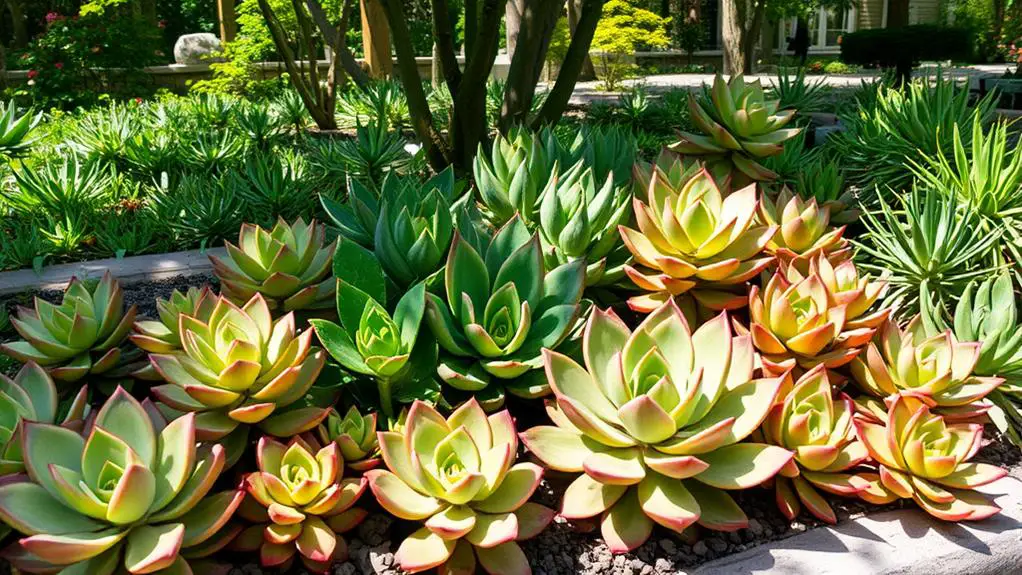
To manage sun stress in your succulents, start by gradually acclimating them to more sunlight, beginning with 4-6 hours of morning sun to avoid sunburn.
Keep an eye out for signs of stress like crispy edges or discoloration, and adjust their light exposure if needed.
Make sure to water your plants more often during sunny spells but let the soil dry out between waterings, and consider using shade cloth to protect them during the hottest parts of the day.
Signs of Stress
Healthy succulents can show signs of sun stress that you should watch for.
These signs will help you catch any problems early and keep your plants thriving.
Keep an eye out for:
- Leaf color changes: Your succulent's leaves might turn reddish or purplish. This color change is due to an increase in anthocyanin pigments, which protect against UV rays.
- Sunburn: Look for crispy or brown edges on the leaves. This indicates that your plant has been exposed to too much sun and is getting sunburned.
- Moisture loss: If you notice wrinkled or shriveled leaves, your plant could be losing moisture because of high light intensity. This is a clear sign of stress.
- Stunted growth: If your succulent isn't growing as vigorously as before, excessive sun stress might be the cause.
Gradual Acclimatization
When introducing your succulents to more sunlight, you'll want to ease them into it to prevent shock and sunburn. Gradual acclimatization is key here. Start by giving your succulents 4-6 hours of morning sun, which is less intense than afternoon light. Over the next few weeks, slowly increase their exposure to direct sunlight based on how they respond.
Monitor signs of stress, like discoloration or crispy leaf edges, and adjust their light exposure if needed. Ideally, do this when temperatures are between 65-75°F, as these conditions support healthy growth while they adapt to the increased light.
Rotating your succulents regularly guarantees they get even sunlight distribution. This promotes uniform acclimatization and reduces the risk of uneven sun stress.
Here's a simple table to help you track your acclimatization process:
| Week | Sunlight Exposure | Temperature Range |
|---|---|---|
| 1 | 4-6 hours morning | 65-75°F |
| 2-3 | 6-8 hours | 65-75°F |
| 4+ | Full sun as needed | 65-75°F |
Moisture and Shade
As you gradually acclimate your succulents to more sunlight, managing moisture and shade becomes equally important to prevent sun stress. High sunlight can cause succulents to lose water quickly, leading to dehydration and damage.
To keep your plants healthy, you need to monitor soil moisture levels closely. Make sure the soil dries out between waterings but don't let it stay dry for too long, especially during peak sunlight hours.
Here are some practical steps to help you manage moisture and shade:
- Check Soil Moisture Regularly: Use your finger to test the soil. If it's dry an inch below the surface, it's time to water.
- Use Shade Cloth: A shade cloth can protect your succulents from excessive heat and reduce moisture loss while still allowing sunlight through.
- Strategic Placement: Place your succulents where they get filtered sunlight, like under a tree or near a shaded patio.
- Afternoon Shade: During hot days, provide shade in the afternoon to prevent sunburn while still giving them morning sunlight for vibrant growth.
Safe Sun Stressing Methods

To safely sun stress your succulents, start by gradually acclimating them to increased sunlight exposure. Begin with 4-6 hours of morning sun to minimize the risk of sunburn. Sun stress can bring out beautiful colors in succulents, but you need to do it carefully to keep your plants healthy.
Healthy succulents need time to adapt to the sun. Monitor for signs of sun stress, such as leaf discoloration or crispy edges. If you notice these, reduce their sunlight exposure slightly. This way, you prevent excessive damage while still promoting beneficial sun stress effects.
Choose resilient succulent varieties like Sedums. They handle sun stress well and often show vibrant color changes, adding beauty to your garden. Make certain they're planted in well-draining soil, which helps them adapt to stress without becoming over-saturated.
During the hottest parts of the day, use filtered sunlight or indirect light to protect sensitive plants. This gives them the benefits of sun stress without causing harm.
Remember to let your succulents dry out between waterings, as this balance is vital for their adaptation. With these steps, your succulents will thrive and show their best colors.
Environmental Adjustments
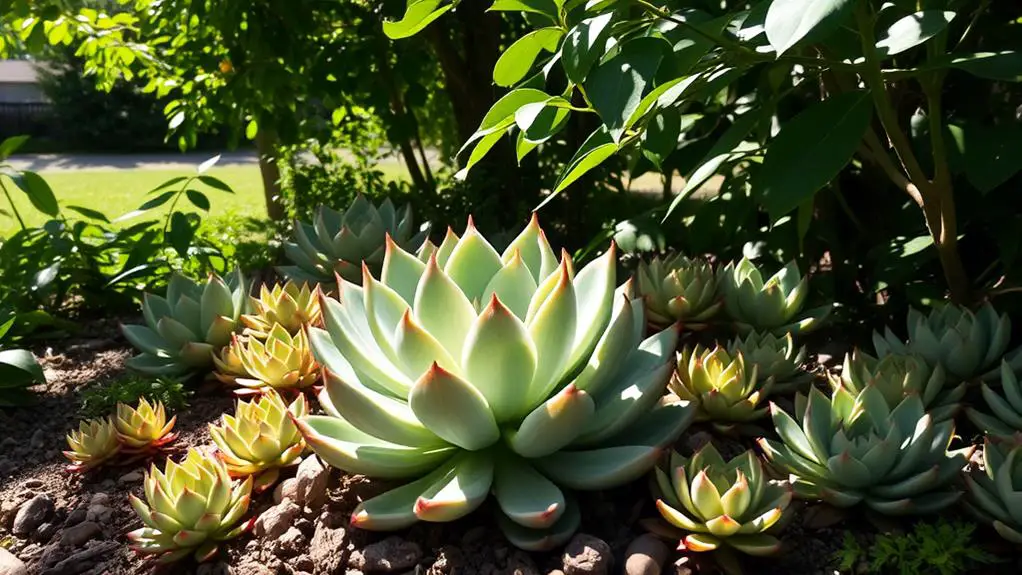
Making environmental adjustments is essential for successfully managing sun stress in your succulents. Understanding and controlling environmental factors will help you navigate the sun-stressing process effectively. Here are some key adjustments to take into account:
- Amount of sunlight: Provide your succulents with morning sunlight to minimize the risk of sunburn. Avoid harsh afternoon rays, which can harm sensitive plants.
- Temperature and humidity: Aim for temperatures between 65-75°F. Succulents show more intense colors when exposed to cooler temperatures below 60°F. Keep humidity levels low to replicate their natural arid environments.
- Good air circulation: Ensure adequate airflow around your succulents. This reduces humidity and prevents mold or rot, creating a healthier environment.
- Outdoor conditions: Whenever possible, place your succulents outdoors. Outdoor setups naturally mimic the arid conditions succulents thrive in, making it easier to manage sun stress.
Additionally, using LED grow lights can be an alternative to natural sunlight. Be sure to adjust light intensity and duration based on your succulents' needs.
Care During Sun Stress

Caring for succulents during sun stress involves a few key practices to secure their health and vibrant appearance.
First, gradually acclimate your succulents to increased sunlight exposure. Start with 4-6 hours of morning sun to prevent sunburn. It's important to regularly monitor signs of sunburn, such as black or brown spots on the leaves. If you notice these spots, adjust the light exposure to protect your plants.
Next, consider the watering frequency. During sunny conditions, succulents lose moisture more quickly, so you should increase watering. However, make sure your soil is well-draining to avoid overwatering, which can harm the plants.
Fertilizing your succulents can also support healthy growth and enhance their color change during the growing season. Be cautious with fertilizers to avoid stressing the plants further.
Additionally, rotating your succulents regularly secures even sunlight distribution. This promotes consistent color change and prevents any one side from becoming overly stressed.
Common Questions
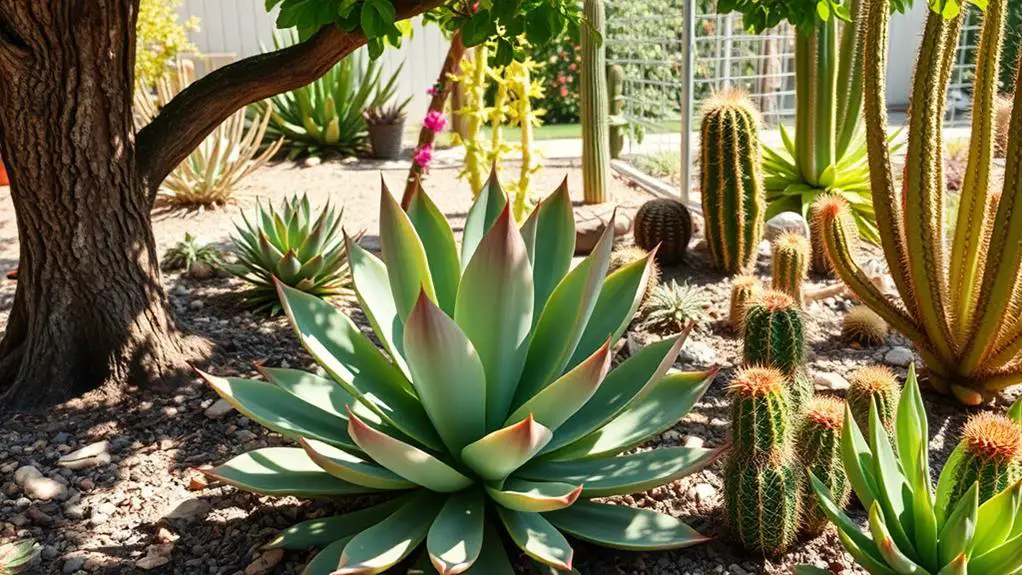
Understanding how to care for succulents during sun stress naturally leads to several common questions. You might wonder if sun stress is a good thing, how it affects your plants, and what signs to watch for. Here are answers to some of the most frequent questions:
1. What are the benefits of sun stress on succulents?
Sun stress can enhance the coloration of your succulents, resulting in vivid reds, purples, and yellows. These colors come from increased anthocyanin and carotenoid production, which protect the plants from UV rays.
2. How do I know if my succulent is sun-stressed?
Look for leaf color changes, crispy or brown edges, and stunted growth. These signs indicate that your succulent is exposed to more sunlight than it can handle and needs careful management.
3. How can I acclimate my succulent to more sunlight?
Gradually increase sunlight exposure, starting with 4-6 hours of morning sun. This helps minimize the risk of sunburn and other damage.
4. What should I do if my succulent shows signs of overexposure?
Adjust its care practices, such as watering frequency and shading, to guarantee it stays healthy. Monitoring is key to keeping your colorful succulents vibrant and thriving.
Frequently Asked Questions
Is Sun Stress Bad for Succulents?
Yes, sun stress can be bad for succulents. If you notice black or brown spots, crispy edges, or shriveled leaves, it's time to adjust their light exposure. Gradually acclimate them to prevent damage and monitor their condition.
How Long Does It Take to Sun Stress Succulents?
To sun stress succulents, start with 4-14 days of gradual exposure. Begin in filtered sunlight or partial shade, then shift to direct sunlight. Monitor closely for signs of stress to find the best timeframe for each type.
Is It OK to Put Succulents in Direct Sunlight?
Yes, you can put succulents in direct sunlight, but do it gradually. Start with morning sun and increase exposure to avoid sunburn. Monitor moisture levels to prevent dehydration. Some varieties may need partial shade during peak heat.
Is It Possible for Succulents to Get Too Much Sun?
Yes, succulents can get too much sun. You should watch for signs like black or brown spots and crispy edges. Gradually introduce them to more sunlight and monitor their condition to prevent sun damage and stunted growth.
Conclusion
You've got this! By understanding and managing sun stress, your succulents can thrive and show off their stunning colors. Remember to introduce them to more sunlight gradually and keep an eye out for any signs of distress. Adjusting your care routine, like watering and shading, will help your plants stay healthy. With a little patience and attention, you'll enjoy vibrant, compact succulents that are both beautiful and resilient. Happy gardening!

